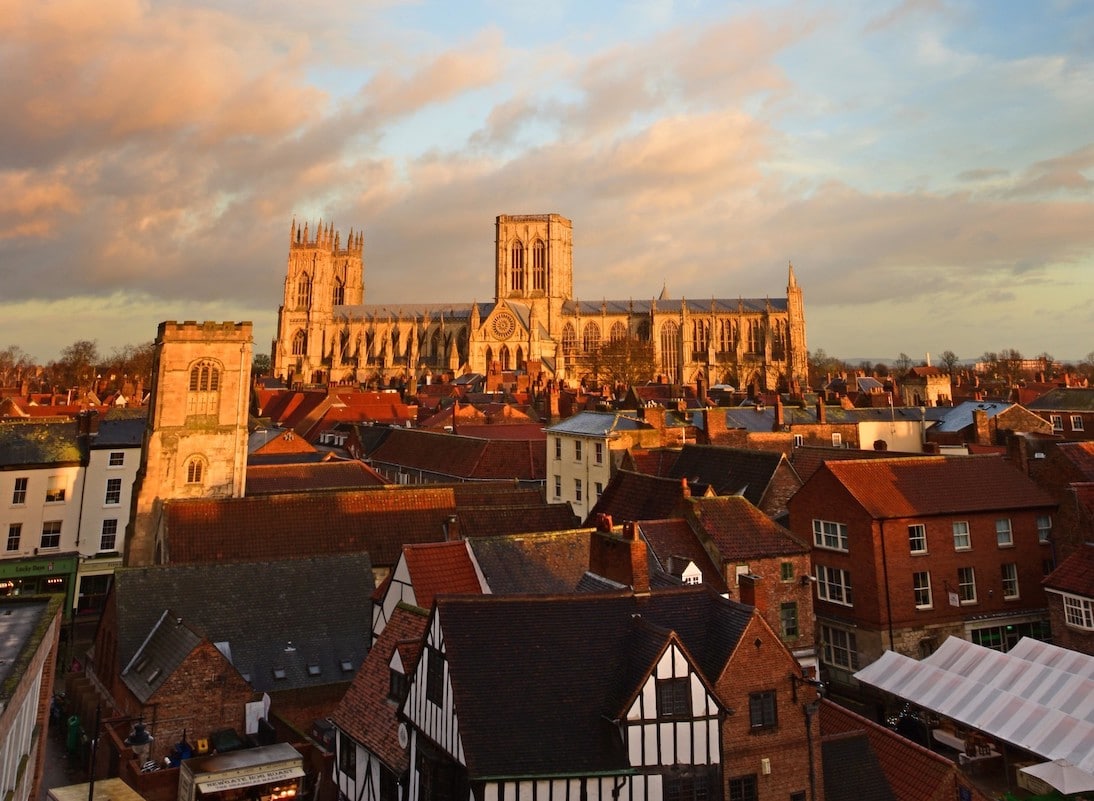
Built atop the ruins of an old Roman fort and consecrated in 1472, York Minster Cathedral dominates the skyline of York. The Medieval masterpiece is famous for its stained glass windows. It survived the War of the Roses, the confiscation of ecclesiastical property by King Henry VIII and the Luftwaffe bombing in World War II. Photo by VisitYork.org
By Nancy Wigston
When the London train pulls into York’s Victorian Station, doors open onto an earlier time. Under the grand sweep of the station roof, travelers come and go, amid news agents, booksellers and tea rooms. It’s hard not to think of the station and its buffet as portrayed in the 1945 David Lean film classic, Brief Encounter, where two respectable married commuters meet, fall in love and then, after painful reflection, part ways.
Younger film fans may recognize the 1877 station from the first Harry Potter film, where York’s train station stood in for London’s King’s Cross in a scene where young Harry catches the train to Hogwarts Castle at Gate 9 ¾.
York was chosen by Potter filmmakers for the old-fashioned bridge over its tracks, a feature Kings Cross lacks. No coincidence perhaps, that Britain’s National Railway Museum is just over the road, a vast showcase of railway history from the earliest steam locomotives to the sleekest Japanese bullet trains. Its faux-railway buffet is named, naturally, “Brief Encounter.”
Brief encounters aside, fascinating experiences await visitors to this medieval walled city at the junction of the rivers Ouse and Foss. Midway between London and Edinburgh, York attracts several million visitors a year–history buffs, English atmosphere junkies, and madcap hen parties—the latter identified by “Team Bride” t-shirts and larking about behavior in a city that boasts some of the greatest architecture in the United Kingdom.
Romans and Saxons and Ghosts, Oh My!
York novelist Kate Atkinson captures the moody mysteries of her hometown in her prize-winning novel Behind the Scenes at the Museum with this child’s description of her parents’ shop located, “in one of the ancient streets that cower beneath the looming dominance of York Minster. In this street lived the first printers and the stained-glass craftsmen that filled the windows of the city with coloured light. The building that our shop occupies is centuries old and its walls tilt and its floors slope like a medieval funhouse.”
A resident ghost inhabits the house in Atkinson’s book. But then ghosts abound in York, where the line between fact and fiction often blurs.
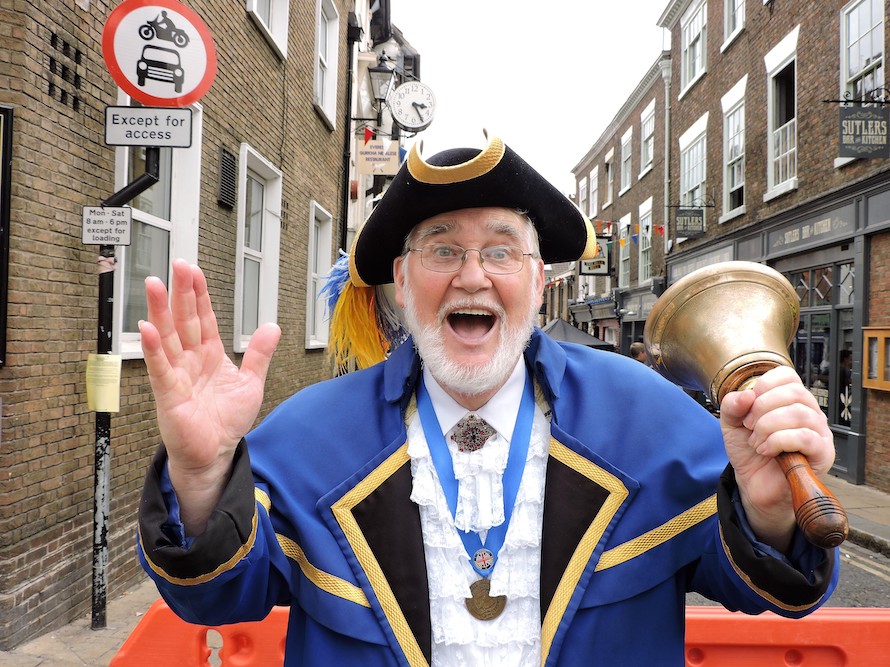
Town Criers in York used to walk the streets at night giving verbal assurance that “All is well.” Today they pose for selfies and enlighten curious tourists. Photo by Nancy Wigston
The Roman Empire’s Ninth Legion Hispaña that conquered Northern Britain was headquartered in York, where it patrolled the streets as a via praetoria until it mysteriously vanished into thin air sometime around 120 AD. Catholic radical Guy Fawkes was born here. Eighteenth century highwayman Dick Turpin was hung a few streets away from where Fawkes once lived. And then there’s Daniel Defoe, a journalist, pamphleteer and spy, whose 1719 novel Robinson Crusoe is said to rank second only to the Bible in its number of translations.
Uplifting and majestic, York Minster Cathedral, often called “The Minster,” looms above the cityscape with soaring spires, Gothic grotesques and a Central Tower (reserve to climb it.). Two hundred and fifty years in the building, this ecclesiastical landmark has dominated the cityscape since it was consecrated in 1472. First built in the 7th century atop a ruined Roman fort, The Minster contains the greatest concentration of medieval stained glass in the country. Its Great East Window is thought to be the largest area of stained glass in Europe. Families follow child-focused treasure maps around the vast interior, watched over by carvings of pious figures from past centuries, discovering artifacts fashioned by the country’s earliest inhabitants, including Romans.
Romans relaxing in the bath
In A.D. 71, York was the Roman fort Eboracum. When not empire-building, soldiers spent their free hours unwinding in baths, like those discovered in the basement of a Victorian pub after a 1920s fire—inspiring the pub’s new name, The Roman Bath.
Constantine the Great, proclaimed Emperor here in 306 AD., became the first Roman Emperor to convert to Christianity, founding Constantinople (today’s Istanbul) in 324 A.D. His 1998 bronze statue by sculptor Philip Jackson broods handsomely outside The Minster. “So confident, almost sultry,” a passing visitor remarked of the good-looking emperor on the day of my visit.
Constantine enjoys something of a local following, attracting the attention of the Yorkshire Party which often places a Rowntree Kit Kat bar in one imperial hand and a Terry’s Chocolate Egg in the other. Both are York-made sweets.
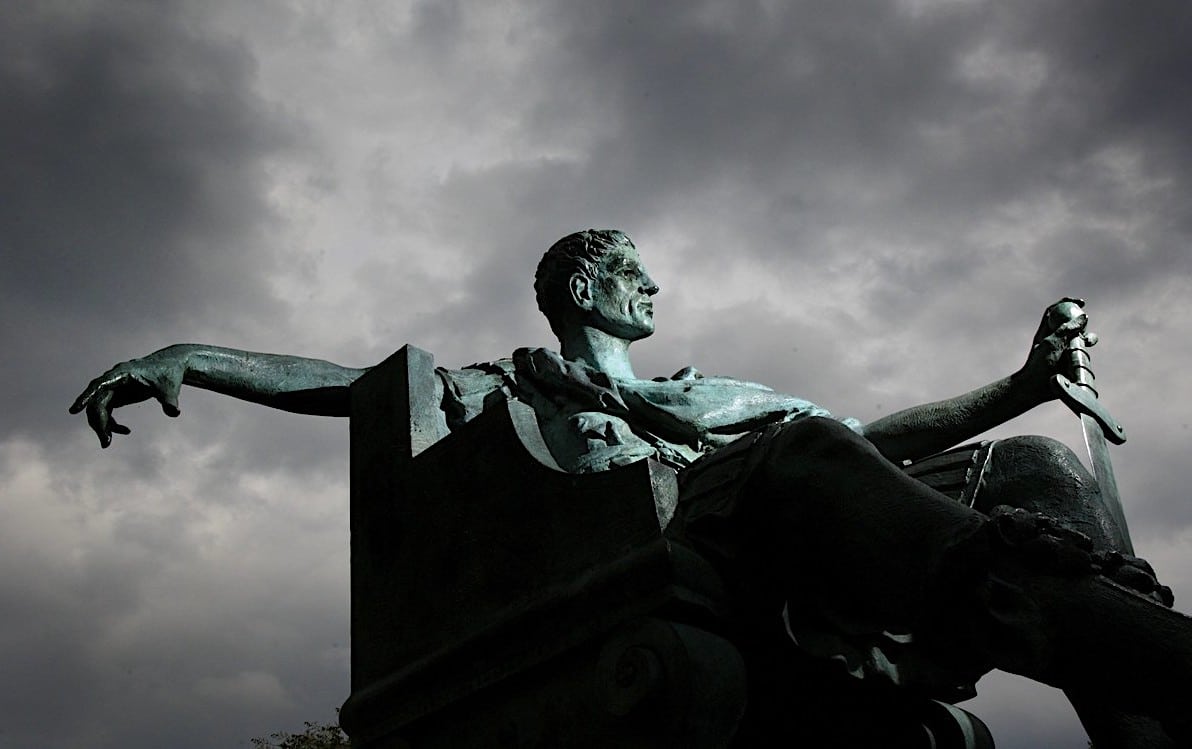
Constantine was proclaimed Emperor of Rome in 305 A.D. He later founded the city of Constantinople, which became the seat of the Byzantine Empire. Several of the buildings he started still dominate the skyline of modern Istanbul. Photo by VisitYork.org
Ghosts and failed revolutions
The Romans departed around 400 AD., leaving behind their baths, fortresses, villas—and specters. “Europe’s most haunted city” draws fans of the paranormal to the Treasurer’s House where the Minster’s treasurer once lived. A few ghosts float about the main rooms but the real thrills await in the basement. Put on a hard hart and crawl through the tunnel after your guide to reach the spot where 18-year-old apprentice heating engineer named Harry Martindale, was working in 1953.
Hearing a trumpet blast, he looked up and saw a helmeted Roman officer, a horse cart, and twenty tired and dusty Roman soldiers, marching on what later was discovered to be a buried Roman road. Appearing through one wall, they vanished through another. Shaken by his experience, Harry took some time off and changed careers, becoming a policeman.
Steps away from the Minster you’ll find St. Michael le Belfrey, the restored Protestant Church where Guy Fawkes, England’s most recognizable political villain, was baptized on April 16, 1570.
Converted in his youth to the Catholic cause, Fawkes learned the art of explosive-making while fighting for Spain, as “Guido Fawkes.” On his return to London, he joined a plot to blow up Parliament and kill the anti-Catholic King James I on November 5, 1605. Discovered beneath Westminster with 36 barrels of gunpowder on November 4, Fawkes was tortured and confessed, then sent to the gallows for treason.
The failed gunpowder plot was devised by Robert Catesby and fellow conspirators, but Guy Fawkes alone reaped the notoriety. To this day his likeness is burned in effigy on Bonfire Night (“Remember, remember the fifth of November”), when fireworks and explosions punctuate England’s dark November skies.
At St. Michael le Belfrey, until two in the afternoon on November 5, Fawkes’ baptismal certificate is on display. Young would-be revolutionaries celebrate today by putting on masks that display the goateed 17th century visage of Fawkes. Drink too much and need to crash? Then spend the night at the Guy Fawkes Inn two minutes’ walk away from The Minster.
Relax with a comforting beverage
With so much to see and absorb, it’s frequently necessary to stop for what the English call a “cuppa,” that’s tea of course. In York that means Bettys, a 1919 café and tearoom. Its interior is modeled on the ocean liner, Queen Mary. This York institution is a serious tourist draw, so if lines aren’t your thing try The Ivy, also centrally located on St Helen’s Square.
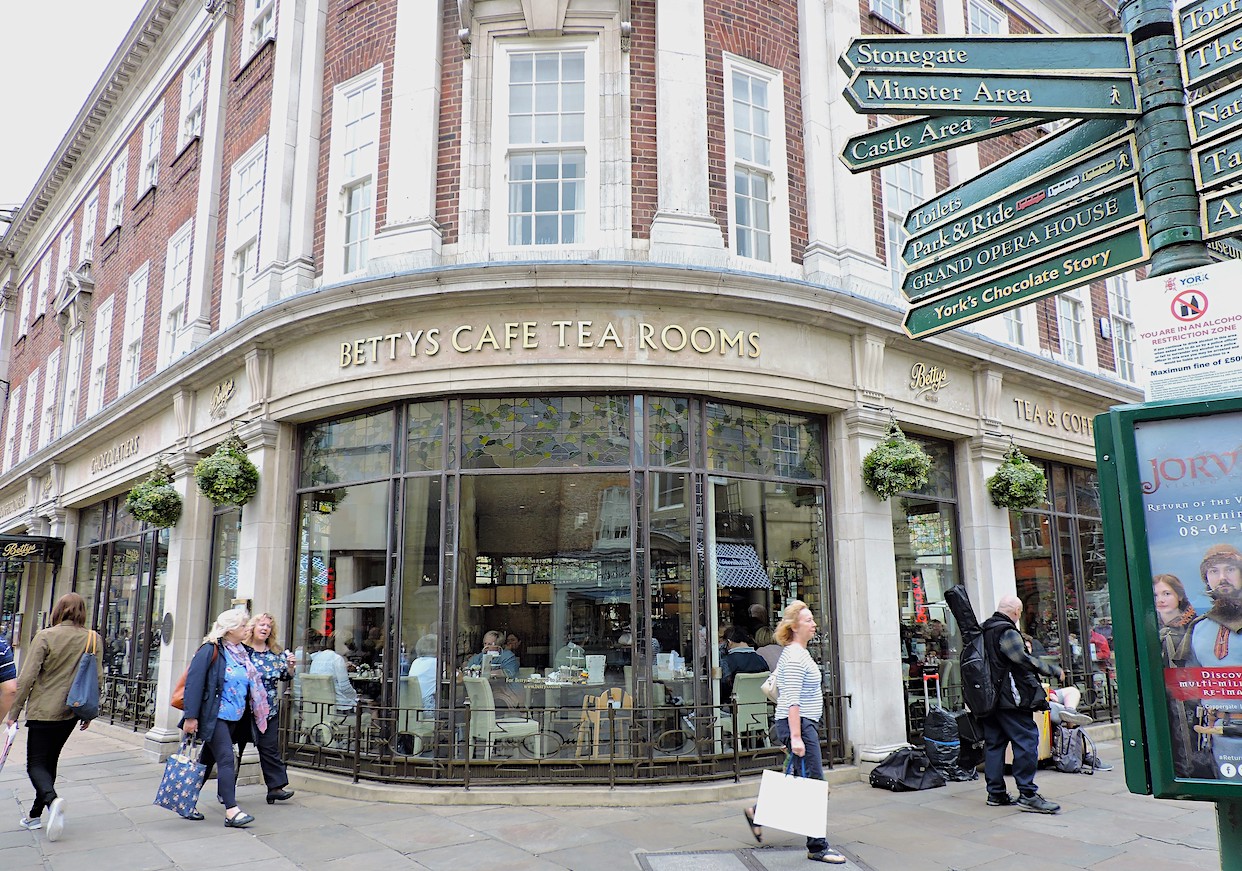
In need of a cuppa? Then stop at Bettys Tea Room, a cafe lavishly furnished to resemble an ocean liner. Photo by Nancy Wigston
Traditional roast beef and Yorkshire pudding with potatoes and sprouts are very tasty at The York Roast, which has two locations at Stonegate and Low Petergate. For your choice of dishes from the greater world, try the funky scene at Spark, 17-21 Piccadilly, where refurbished shipping containers house international street food vendors serving Columbian vegan stew, Italian pizzas and Greek desserts. On the banks of the River Ouse, you’ll find cafes and pubs offering wines and ales. Try the Black Sheep, a local favorite.
During York’s chocolate-making heyday, families like Rowntree’s and Terry’s employed 15,000 chocolate makers. Take the highly recommended York Chocolate Story tour if you appreciate history and free samples. Then celebrate your chocolate awareness with a cup of hot chocolate served at York Cocoa House. There are boxed chocolates and kitchen tours, but foot-weary tourists may just want to sit and sip. As the cobblestones of Castle Street glisten after a shower and Bill Withers’ “Ain’t No Sunshine” plays in the background, contentment reigns.
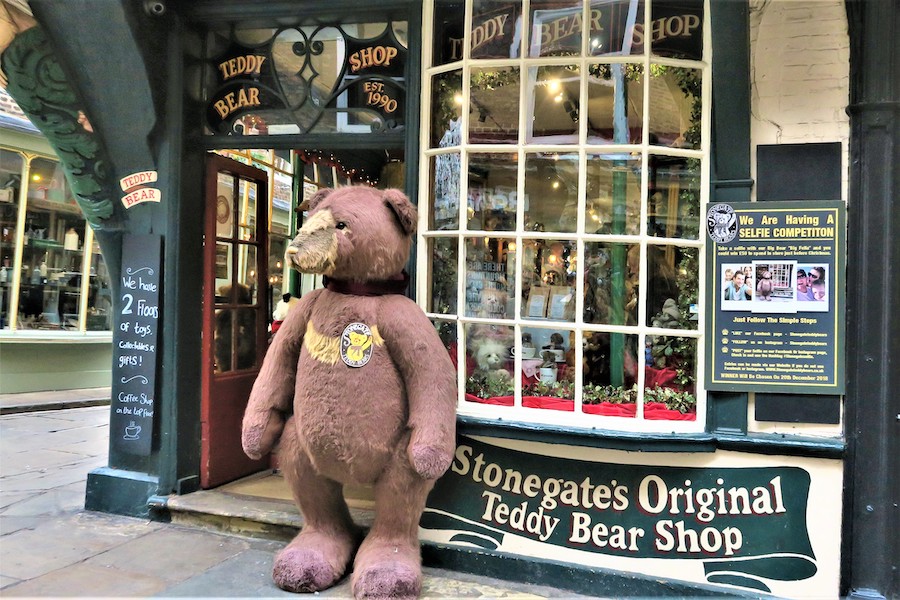
Stonegate’s Original Teddy Bear Shop is 31 years old, but the building it inhabits is much older. York’s present prosperity results from its preservation of the past. Photo by Nancy Wigstron
About the English weather: the sun will surprise you just as often as the rain, as will frequent rainbows.
Although drenched in somewhat bloody English history (King Charles I ruled from York for six months before meeting his unfortunate end), York today is the very picture of lively, chic, culturally diverse England. The “city center” (English for downtown) is a warren of pedestrian-friendly streets where North African, Middle Eastern, Thai and Japanese restaurants occupy refreshed spaces dating from the Middle Ages.
Where once were abbeys, Gardens grow
Modern bustle amid muted ruins distinguish today’s York. In the center of town, for instance, the soaring ruins of St. Mary’s Abbey–a casualty of Henry VIII’s seizure of church lands–frame an outstanding 10-acre botanical garden. The magic of York is that any given corner resembles a movie set where an office worker can eat sandwiches on a bench beside a massive pillar built by the Romans.
Hot type and hotter tales
Stonegate is a street particularly rich in history, boasting not only the address where young Guy Fawkes lived but also the house where the Rev. Lawrence Sterne wrote his wildly comic novel, The Life and Opinions of Tristram Shandy, Gentleman, an 18th century masterpiece still in print today. In Sterne’s time, Stonegate bustled with printers and publishers. Apprentices handling hot type were blamed for mistakes and typos, earning the boys the nickname “red devils” like the one perched above a former printer’s shop on Stonegate.
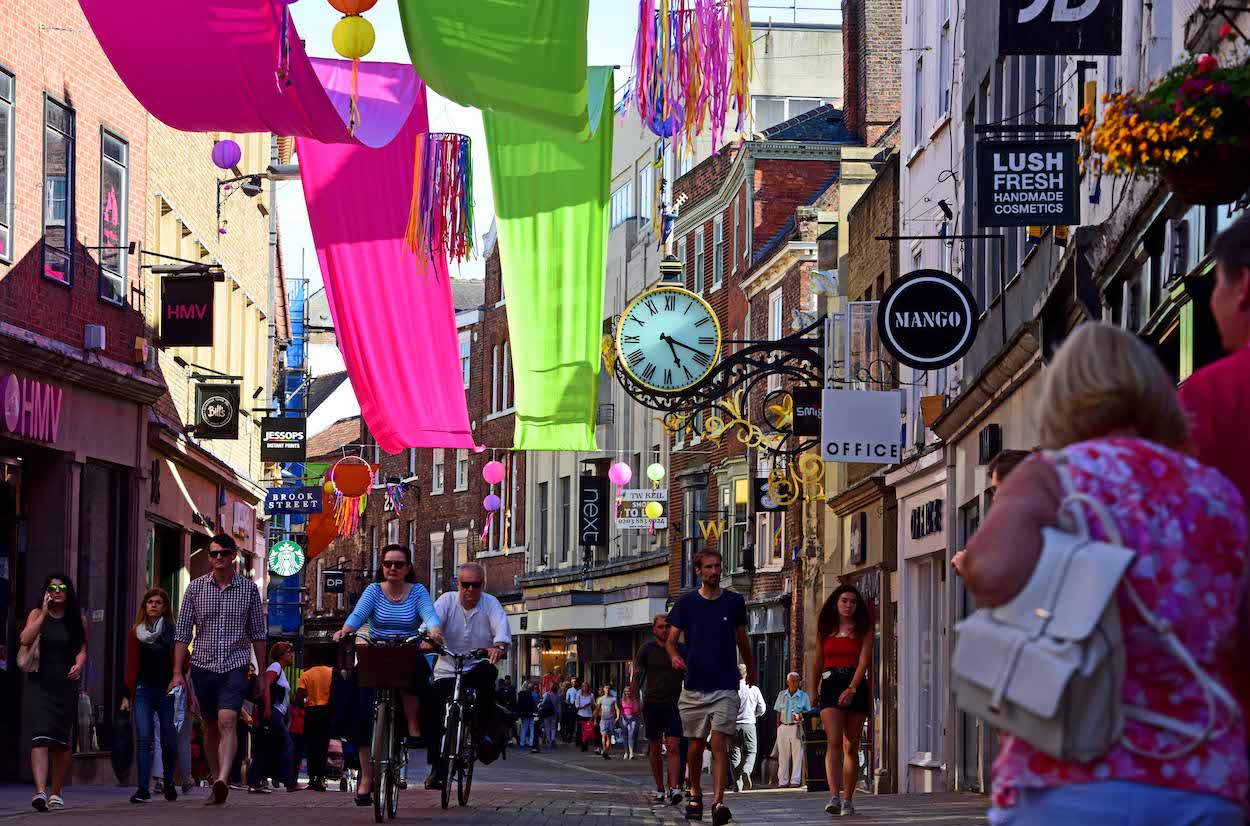
York’s Floribunda Coiney Street has a wide array of shops that attract a diverse clientele. Photo by VisitYork.org
One afternoon, as two shoppers emerge from a Stonegate shop, happy with their purchases– cashmere sweaters against the northern chill—an elderly man approaches, “Are you visiting York?” Pointing to a framed photo attached to the wall, he informs them that the lady in the photo is the Queen’s grandmother, photographed as she exited the same shop when it sold antiques. “Oh, Queen Mary,” comes a reply. The man looks taken aback—how did she know? But he recovers quickly and moments later is heard asking other strollers, “Are you visiting York?”
York is symbolized by a flower, the white rose, and as you move about town you might see a white rose on shop fronts, placards and plaques. The rose is a heraldic badge dating back to the 14th century. It became a city symbol in the mid 15th century when York battled Lancaster, symbolized by the red rose, for control of Plantagenet England in a decades-long struggle called the War of the Roses. The war finally ended when Henry VII ascended the throne, combined the two roses into a single flag and created the Tudor Dynasty.
Spend-ups, entertainments and snickets
Weekends in York are not only for “spend-ups” as the English say, but street entertainments. You’ll no doubt encounter freelance history guides, groups of fire eaters, hip-hopping kids, plus singing buskers and musicians as you walk about. The man we saw sitting under a guillotine was probably advertising a Ghost Tour rather than offering to chop off his head. But no one stopped to find out.
Unmissable is The Shambles, York’s perfectly preserved medieval passageway that was formerly home to butchers’ stalls. Today it’s thronged with touristy souvenir and candy shops. One vendor sells wands and wizard gear, Harry Potter-style. With extremely narrow, half-timbered rooftops leaning inward, this winding street is one of many crisscrossed by alleys called “snickelways” or “snickets” in local parlance. Exploring snickets allows you to follow shortcuts once taken by officials eager to avoid the lower orders. Names like Grape (formerly Grope) Lane, Mad Alice Lane and Swinegate add to the fun of medieval walking.
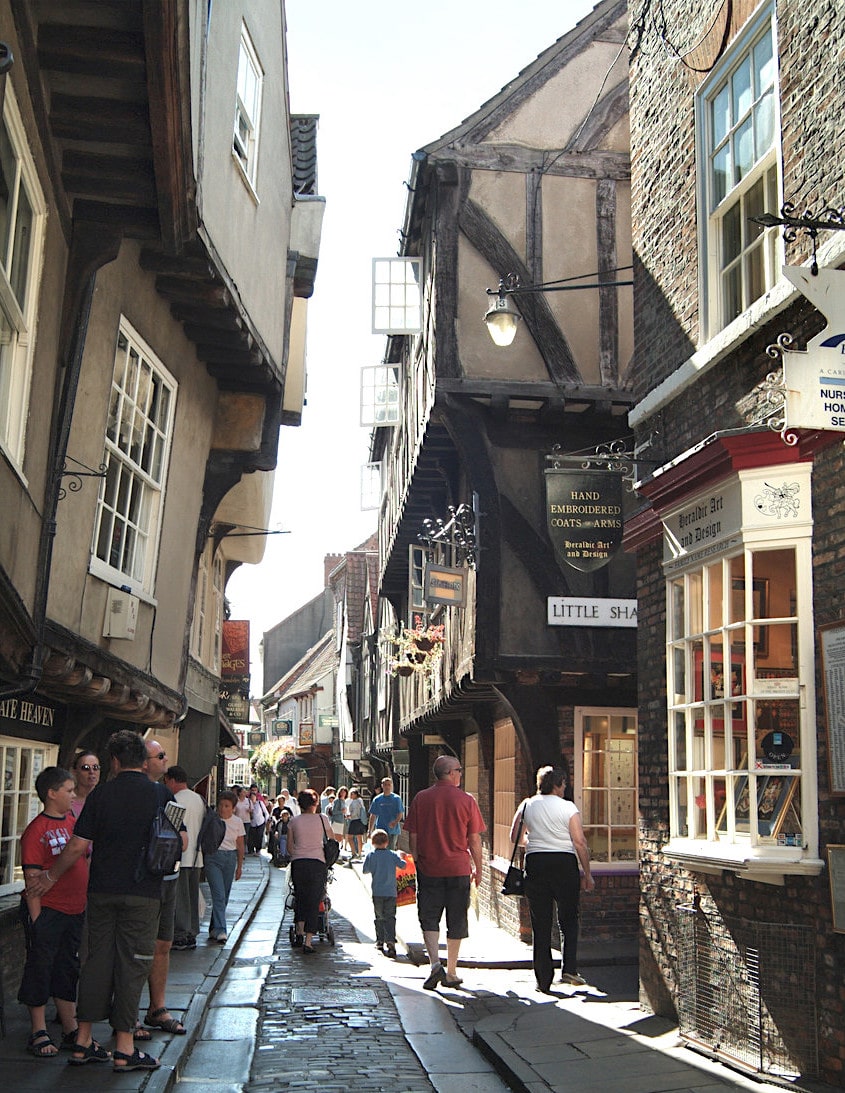
York’s most famous street, The Shambles, hasn’t changed much since Medieval times. There’s even a shop for wizards in search of a new wand. Photo by VisirtYork.org
Most people know about 1066—the year the Normans conquered Britain. Clifford’s Tower is all that remains of York’s original Norman Castle. Few realize today that by 866 A.D., Vikings—Danes mostly—who arrived after the Roman empire crumbled, were in charge. They named their town Jorvik and made it a lively trading and manufacturing center. Current films and TV shows portray a somewhat exotic and often violent Viking world, but the same folk, by contrast, are rather fondly regarded in York. “I was a Viking last year,” a little girl cheerfully informs everyone in a Saturday morning queue in front of the Jorvik Center. Her school classes were grouped into Romans and Vikings.
It wasn’t until 1976 that archeologists discovered a 1000-year-old Viking city deep under Coppergate (“Cup makers’ street” in Norse.) Five years of digging revealed copious evidence of a very old world indeed. When the Jorvik Center opened, it became one of Britain’s most popular tourist attractions. Kids and adults love it—a transparent ground floor becomes a treasure hunt for Viking objects nesting in the earth: amber jewelry, earth stained red from cloth dyeing, even a toilet.
A slow train takes visitors through a simulated Jorvik, where eerily life-like figures go about their daily lives, making clothing, fashioning crafts, cooking meals. One couple argues over what to have for dinner. Jorvik appears surprisingly diverse—many languages are being spoken–since scholars have discovered that Viking society was, in fact, a multicultural stew.
“Welcome back to 2021,” says the attendant to a delighted boy at ride’s end. A Viking-costumed guide shows visitors the different coins he’s carrying in his leather purse–replicas are for sale in the gift shop—but Ragnarok (his name, he says) never breaks Viking character, from his red braids and iron age jewelry to lively tales of Jorvik life. “Where did the Vikings go when they were defeated?” somebody asks. “Oh, they never left,” comes the nonchalant reply, which fails to mention that Danish Yorkshire was conquered by Saxon English in 954 AD.
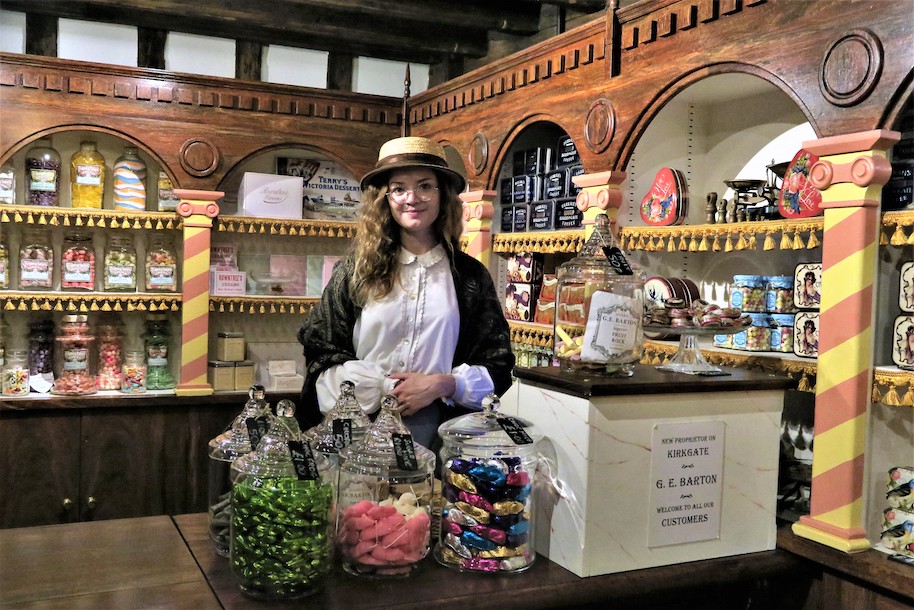
The candy shop at the York Castle Museum sells a staggering array of sweets. Yield to temptation and buy plenty of chocolate. You’ll have plenty of opportunities to walk off the calories. Photo by Nancy Wigston
From its Viking heyday, York has prospered as a trading center, dealing internationally in wool and textiles. A fabulous Middle Ages—The Minster—declined into a war-torn 17th century until peace came in 1688. New centuries attracted fashionable wealth to York, with 18th century balls at The Assembly Rooms, and elegant living in townhouses like the one owned by the Fairfax family. A docent tells visitors that Lord Fairfax defeated the rebellious Catholics of York in 1644, explicitly ordering his men not to sack The Minster, “or all its treasures would have been destroyed.” Curiously, the military Fairfax was a Protestant, whereas the wealthy Fairfax family whose luxurious house is now a museum, were secret Catholics. Anne, the heiress whose portrait graces the drawing room walls, never married, unable, it’s assumed, to find a suitor whose faith matched the strength of her own. “If only we had a ghost,” jokes another docent, “we’d love that.”
Kit Kat bar conquers the world
There were, of course, exceptions to wealth, which brings us to The Quakers and their best-selling Kit Kat chocolate bar. The story goes that an 18th century Quaker grocer named Henry Isaac Rowntree, while gazing one morning on York’s drunk and ragged slum-dwellers, had an idea. Although barred from attending Oxford and Cambridge, entering the army or becoming MPs, Quakers like Rowntree and Cadbury in Birmingham achieved great success marketing cocoa, an exotic import from the new world, which they sold as a healthy alternative to alcohol.
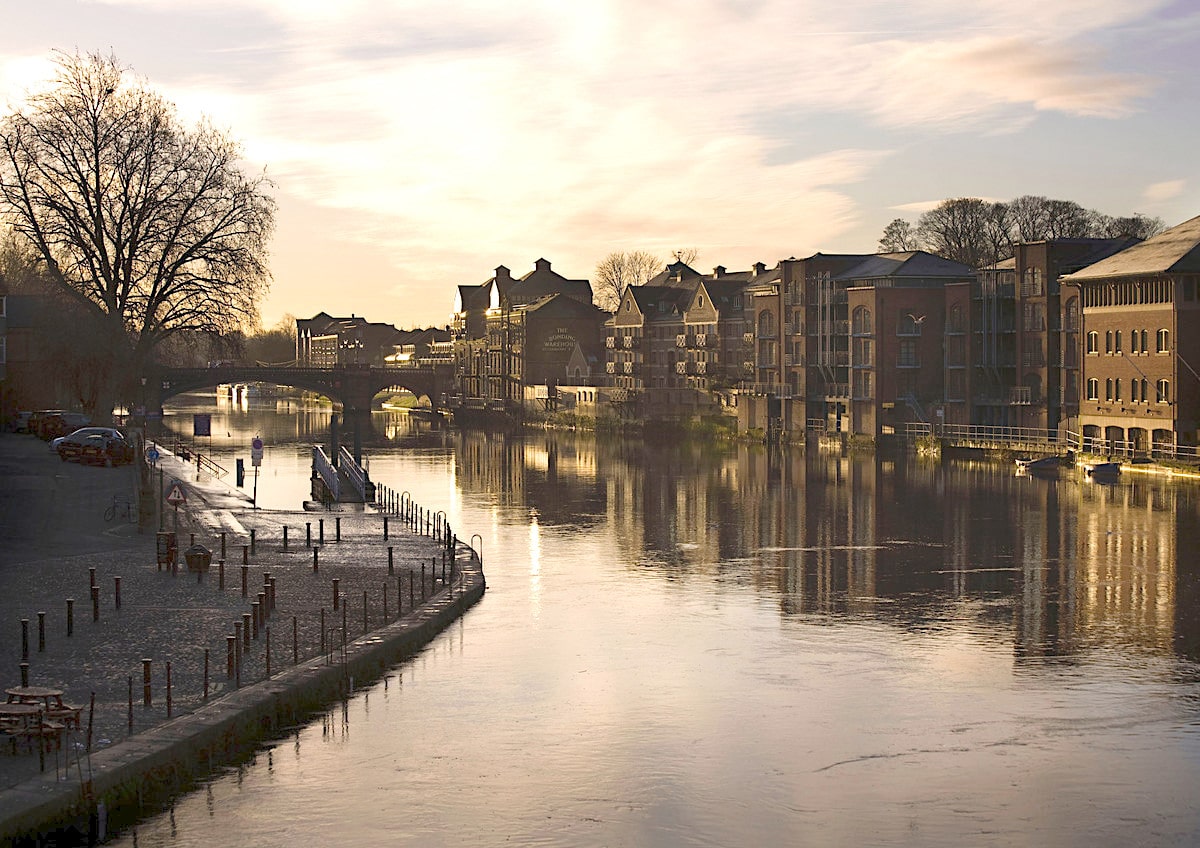
York’s River Ouse at dusk. Photo courtesy of VisitYork.org
Their names and good works live on. The chocolate factory tower in Johnny Depp’s film version of the Roald Dahl novel about a boy named Charlie? That’s the old Rowntree factory. Much earlier, York cocoa makers created the “Retreat,” a facility for the humane care of the mentally ill. It’s still in existence. Rowntree’s workers received pensions, paid holidays, medical and dental care. Henry Rowntree, his brother Joseph, and their descendants went on to build affordable housing, help fund the public library system, and create one of the city’s loveliest parks. Rowntree Park, founded in 1921, remains a wonderland of decorative gardens, duck ponds, playgrounds, tennis courts, and picnicking areas, built to honor Rowntree workers lost in World War I. The swans, of course, belong to the Queen. ![]()
Nancy Wigston is an award-winning travel writer whose work is inspired both by the countries she visits and those where she’s occasionally found homes, including Canada, Malaysia and the United Kingdom.

